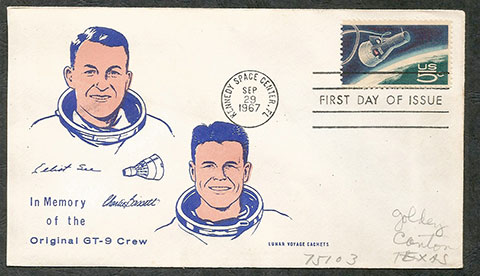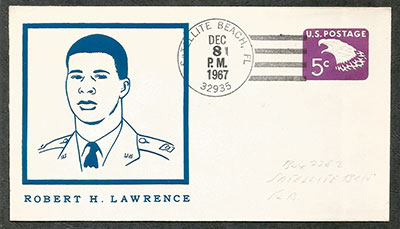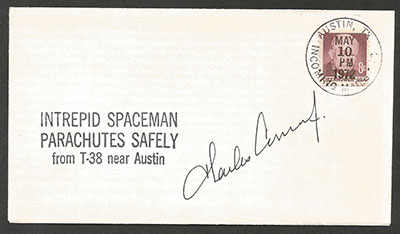|
|

|
|
Author
|
Topic: Space Cover 571: Astronaut air accidents
|
cvrlvr99
Member Posts: 205
From: Arlington, TX
Registered: Aug 2014
|
 posted 08-02-2020 09:49 AM
posted 08-02-2020 09:49 AM
   
Space Cover of the Week, Week 571, August 2, 2020 Space Cover #571: Astronaut aircraft accidentsSince our space program began, 10 astronauts and astronaut candidates have died in airplane accidents. The first of these was Ted Freeman (Candidate) who died in a T-38 crash in Houston on Oct. 31, 1964. On Feb. 26, 1966, two astronaut candidates crashed aboard a T-38 Talon while landing in inclement weather in St. Louis, Missouri. These were Elliot See and Charles Bassett. Clifford Willians died in a T-38 crash on Oct. 5, 1967 in Tallahassee, Florida. He was also a candidate.  Major Robert Lawrence was a Manned Orbiting Laboratory (MOL) candidate and a pilot instructor. On May 16, 1967 while training another major how to conduct a steep glide flare technique in an F-104, the candidate flared too late. The candidate successfully ejected, but the back seat, where Maj. Lawrence was sitting, ejected a couple of seconds after the front seat, and fired Lawrence sideways, killing him. On May 24, 1986, candidate Stephan Thorne died as a passenger in an unspecified aircraft near Alta Loma, Texas. Shuttle astronaut David Griggs, was flying in a WWII-era training plane during his free time on June 17, 1989. Shuttle astronaut Sonny Carter was flying as a passenger, on NASA business, in an Atlantic Southeast commercial airliner, which went down on April 5, 1991 in Georgia. Shuttle astronaut Robert Overmyer was testing a Cirrus VK60 aircraft near the Duluth, Minnesota airport when his plane crashed, killing him on March 22, 1996. Dr. Patricia H. Robertson, a NASA astronaut candidate, died as a passenger in a two-seat experimental aircraft near Manvel, Texas, 20 miles south of Houston, practicing touch and go landings on May 22, 2001.  But Astronaut Charles Conrad did not die when his T-38 Talon's electrical malfunction caused the loss of his instruments in severe weather on May 10, 1972, as determined by an investigation board. Conrad, a Navy captain, ejected safely from a T-38 jet aircraft over Bergstrom AFB near Austin, Texas. The husband of a friend of mine was at Bergstrom AFB on that date and canceled a very few covers that evening and sent one to me. A few years later I was sending two items, my maximum, to Conrad for his signature and included this cover as a gift to him. But instead he signed, and returned all three items to me, giving me this very unique cover for this very close call. |
Ken Havekotte
Member Posts: 3670
From: Merritt Island, Florida, Brevard
Registered: Mar 2001
|
 posted 08-02-2020 11:48 AM
posted 08-02-2020 11:48 AM
   
A good report, Ray, on those astronauts that have lost their lives in aircraft accidents.I did note that the term "candidate" had been used for Elliot See, Charles Bassett, and Clifton Williams in the posting. All three of those NASA astronauts were no longer candidates at the time of their deaths. In fact, See and Bassett were chosen to pilot Gemini 9 with See working for the space agency since Sept. 1962, and Bassett for more than 2 years. Cliff Williams, while not assigned as a prime Gemini crewman, had been assigned as the backup Gemini 10 pilot before his T-38 jet crash. He was a NASA astronaut for 4 years. Perhaps a few others should be added on the list. One would be civilian or commercial test pilot Michael Alsbury that lost his life on Oct. 31, 2014 (another Halloween-day tragedy) while on a SpaceShipTwo powered test flight over Mojave Spaceport, CA. Two X-15 research pilots, Michael Adams and Joe Walker, should perhaps be included on the list as well in this category. Since Robert Lawrence wasn't a NASA astronaut, as neither were Alsbury, Adams, nor Walker, but Adams and Walker did achieve a 50-mile(+) altitude flight that qualified them for the astronaut rating-title. Michael Alsbury, on the other hand, was honored as the first "private astronaut" that lost his life during a flight test. His name was recently added on The Space Mirror of the Astronauts Memorial Foundation at KSC in Jan. 2020. All the other astronauts named were recognized or included on The Space Mirror except for Thorne, Griggs, Overmyer, and Robertson. And while on the same topic, don't forget X-15 pilot John McKay that died of complications of injuries suffered in a 1962 X-15 crash landing, X-20 astronaut-pilot Russell Rogers killed in an F-105 explosion in 1967, and perhaps James Taylor of the MOL astronaut program. He lost his life in a T-38 jet, but it was just after the MOL program had been cancelled a year earlier. |
micropooz
Member Posts: 1706
From: Washington, DC, USA
Registered: Apr 2003
|
 posted 08-02-2020 04:58 PM
posted 08-02-2020 04:58 PM
   
Great topic Ray! Here are a couple more covers that relate:George Goldey did manage to get some covers over to the Canton, TX post office on February 28, 1966 when Bassett and See were killed in their plane crash in St. Louis (n.b. - Goldey got Bassett's first name wrong on the cachet).  And here is the B-70 flight event cover from June 8, 1966, when X-15 astronaut Joe Walker collided with it, killing him and Maj Carl Cross, the B-70 co-pilot.  |
cvrlvr99
Member Posts: 205
From: Arlington, TX
Registered: Aug 2014
|
 posted 08-11-2020 06:58 PM
posted 08-11-2020 06:58 PM
   
Thanks Ken and Dennis for the additional information. The sharing of info on this site and during our occasional large and small Space Unit meetings, as well as our personal interchanges, help all of us who actively follow the story of space exploration. Hope to see each of you and hopefully some of our other members at future events. |
Bob M
Member Posts: 1866
From: Atlanta-area, GA USA
Registered: Aug 2000
|
 posted 08-12-2020 01:49 PM
posted 08-12-2020 01:49 PM
   
Back in 1974 two astronauts had aircraft accidents that are probably little known or remembered. Fortunately neither was killed, but one suffered serious burns. Shuttle astronaut Karl Henize was involved in a T-38 crash while landing at Bergstrom AFB but suffered no injuries - "not even a bruise or scratch." Apollo 13 and ALT astronaut Fred Haise was involved in a serious aircraft crash also in 1974. He suffered burns when the Confederate Air Force (now Commemorative Air Force) WWII aircraft he was piloting crashed and burned. In a nice letter to me he stated that he was recuperating and was planning to take his flight physical soon, but still had to wear arm and leg wraps to prevent scarring. Of course, he completely recovered and later was one of the four astronaut pilots involved the the ALT/Enterprise test flights. Also X-24B lifting body pilot Mike Love was killed in an F4 Phantom aircraft crash not long after the end of the X-24B program. Mike Love was a highly regarded pilot and perhaps, like fellow X-24B pilot Dick Scobee, may have also become a NASA Astronaut had he lived. |
Ken Havekotte
Member Posts: 3670
From: Merritt Island, Florida, Brevard
Registered: Mar 2001
|
 posted 08-13-2020 09:32 AM
posted 08-13-2020 09:32 AM
   
As Bob has pointed out, yes, there had been other astronaut non-fatal accidents, in addition to other test pilot aircraft accidents. As in the case of air force X-24B pilot Mike Love, though he was never considered an astronaut with NASA, the X-15/X-20 Dyna-Soar programs, MOL, nor any commercial spaceflight training, it's quite possible Love would have joined one of the first shuttle group selections by NASA. But in opening that door of other pilots that have lost their lives in the post WWII period, let's not forget the first research pilot that had been killed in the line of duty. His name was Howard "Tick" Lilly, the first NACA engineering pilot assigned to the old Muroc Flight Test Unit in CA. Lilly, the 4th pilot to exceed the speed of sound, lost his life on a D-558-1 transonic research mission accident in May 1948. A month later, Capt. Glen Edwards and four crewmen were killed in their experimental "Flying Wing" aircraft. The old Muroc facility had later been re-named Edwards AFB in honor of Captain Edwards' sacrifice. During the 1950's it was reported that dozens and dozens of military and aviation company research pilots were killed every year, about one per week, and with up to seven recorded in a single month in 1952. Now, I have to admit, that does seem like an awful lot of pilots killed during those early experimental and pioneering flight years. It makes me wonder how many test pilots and other flight crewmen, altogether, were killed in the line of duty since the late 1940's --- hundreds!? Even not too long ago, in 1982, aerospace research pilot Dick Gray was killed during a pilot proficiency flight in his T-37 aircraft. And the list goes on and on with both fatal and non-fatal injuries, but not like it was during those earlier decades of the jet and space age when pilots were always trying to fly faster and higher in new jet aircraft and rocket-powered research vehicles.
|
micropooz
Member Posts: 1706
From: Washington, DC, USA
Registered: Apr 2003
|
 posted 08-13-2020 12:11 PM
posted 08-13-2020 12:11 PM
   
Ken's post about test pilot accidents got me looking back through the old rocketplane flight logs. In addition to the aforementioned death of Mike Adams in the X-15 on Nov 15, 1967, there were two fatal accidents with the X-2: - Engine explosion during a captive flight on May 12, 1953 killing test pilot Jean "Skip" Ziegler and motherplane crewman Frank Wolko.
- Inertia coupling when decelerating from a record Mach 3+ flight on Sept. 27, 1956, killing test pilot Mel Apt and ending the program.
Plus lots of near misses (engine explosions on the X1-#3, X-1D, X-1A, and X-15; hard landings on the M2F2 and twice with the X-15; and Yeager going out of control on the X-1A and NF-104 trying to set records). |
micropooz
Member Posts: 1706
From: Washington, DC, USA
Registered: Apr 2003
|
 posted 09-11-2020 10:01 AM
posted 09-11-2020 10:01 AM
   
I found a couple of applicable covers today! Above is a cover postmarked at Satellite Beach, FL, on October 5, 1967, the date of CC Williams’ death near Tallahassee. I believe the cachet (like Ray’s Robert Lawrence cover above) was done by Bob Rank, but if anyone knows better, please squawk.  And the first man in space, Cosmonaut Yuri Gagarin, died in the USSR on March 27, 1968 in a crash of a MiG-15 trainer jet. Someone (Rank?) got covers postmarked at Satellite Beach and cacheted them as well.
| |
Contact Us | The Source for Space History & Artifacts
Copyright 2023 collectSPACE.com All rights reserved.

Ultimate Bulletin Board 5.47a
|
|

|
 advertisement advertisement

|


















